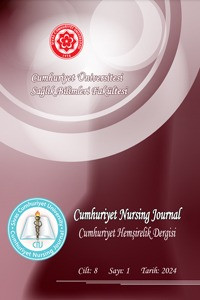Determination of Intensive Care Nurses' Knowledge and Attitudes Towards Preventing Catheter-Related Urinary Tract Infections
Öz
Aim: The aim of this study is to determine the knowledge and attitudes of intensive care nurses towards preventing catheter-associated urinary tract infections.
Method: This descriptive and cross-sectional study was conducted with 123 nurses to determine their knowledge and attitudes towards preventing catheter-associated urinary tract infections. Two forms were used to collect the research data: the "Individual Information Form" and the "Catheter-Associated Urinary Tract Infections Control Measures Scale".
Results: The findings from the study showed that the average total score on the Catheter-Associated Urinary Tract Infections Control Measures Scale was 57.57±8.02. There was no statistically significant relationship between the average total score on the Catheter-Associated Urinary Tract Infections Control Measures Scale and age or total working time in the profession, but a significant relationship was found with gender.
Conclusion: In this study, it was found that as the ages and professional experiences of intensive care nurses increased, their knowledge levels regarding the prevention of urinary catheter infections also increased, and that women had higher knowledge levels compared to men. In this context, the primary aim of healthcare is to identify potential problems in patients beforehand, take preventive measures, and provide effective care. Nurses should be aware of evidence-based guidelines to prevent infections, keep up with updates, and contribute to institutional protocols.
Anahtar Kelimeler
Intensive Care Nurse Catheter-Associated Urinary Tract Infections
Proje Numarası
yok
Kaynakça
- Algarni SS, Sofar SSS, Wazqar DY. Nurses’knowledge and practıces toward preventıon of catheter-assocıated urınary tract ınfectıon at kıng abdulazız unıversıty hospıtal. Journal of Health. Medicine and Nursing, 2019; 4(1):50-73.
- Andrade VL, Fernandes FA. Prevention of catheter-associated urinary tract infection: implementation strategies of international guidelines. Revista Latino-Americana de Enfermagem, 2016, 24, 2678. https://doi.org/10.1590/1518-8345.0963.2678.
- Arli SK, Bakan AB. Development of the catheter associated urinary tract ınfections control precautions scale. Journal of Continuing Education in Nursing, 2018, 49(11), 507–13. https://doi.org/10.3928/00220124-20181017-07.
- Arlı ŞK, Bakan AB. Kateter ilişkili üriner sistem enfeksiyonları kontrol önlemlerine yönelik hemşirelerin bilgi ve tutumlarının değerlendirilmesi. Hacettepe Üniversitesi Hemşirelik Fakültesi Dergisi, 2020; 7(1), 1-7.
Yoğun Bakım Hemşirelerinin Kateterle İlişkili Üriner Sistem Enfeksiyonlarını Önlemeye Yönelik Bilgi ve Tutumlarının Belirlenmesi
Öz
Amaç: Bu araştırmanın amacı yoğun bakım hemşirelerinin kateterle ilişkili üriner sistem enfeksiyonlarını önlemeye yönelik bilgi ve tutumlarının belirlenmesidir.
Yöntem: Bu araştırma yoğun bakım hemşirelerinin kateterle ilişkili üriner sistem enfeksiyonlarını önlemeye yönelik bilgi ve tutumlarının belirlemek amacıyla tanımlayıcı ve kesitsel olarak 123 hemşire ile yapılmıştır. Araştırma verilerinin toplanmasında “Birey Tanıtım Formu”, “Kateter İlişkili Üriner Sistem Enfeksiyonları Kontrol Önlemleri Ölçeği’’ olmak üzere iki form kullanılmıştır.
Bulgular: Çalışmadan elde edilen bulgulara göre Kateterle İlişkili Üriner Sistem Enfeksiyonları Kontrol Önlemleri Ölçeği toplam puan ortalamasının 57.57±8.02 olduğu bulunmuştur. Kateterle İlişkili Üriner Sistem Enfeksiyonları Kontrol Önlemleri Ölçeği Toplam Puan Ortalaması ile yaş ve meslekte toplam çalışma süresi arasında istatistiksel açıdan anlamlı bir ilişki saptanmamıştır ancak cinsiyet ile anlamlı bir ilişki saptanmıştır
Sonuç: Bu araştırmada, yoğun bakım hemşirelerin yaşları ve meslek deneyimleri arttıkça üriner kateter enfeksiyonlarını önlemeye yönelik bilgi düzeylerinde bir artış olduğu ve kadınların erkeklere göre de bilgi düzeyinin fazla olduğu tespit edimiştir. Bu bağlamda sağlık bakımının temel amacı, hastalarda ortaya çıkabilecek sorunları önceden belirlemek, önleyici önlemler almak ve etkili bakım sağlamaktır. Hemşireler, enfeksiyonları önlemek için kanıta dayalı rehberleri bilmeli, güncellemeleri takip etmeli ve kurumsal protokollere katkıda bulunmalıdır.
Anahtar Kelimeler
Yoğun bakım Hemşire Kateterle İlişkili Üriner Sistem Enfeksiyonları
Etik Beyan
Sivas Cumhuriyet Üniversitesi Girişimsel Olmayan Klinik Araştırmalar Etik Kurulu’na başvurularak 2023-12/23 karar nolu etik kurul onayı
Destekleyen Kurum
yok
Proje Numarası
yok
Teşekkür
Araştırmaya katkı sağlayan katılımcılara teşekkür ederim.
Kaynakça
- Algarni SS, Sofar SSS, Wazqar DY. Nurses’knowledge and practıces toward preventıon of catheter-assocıated urınary tract ınfectıon at kıng abdulazız unıversıty hospıtal. Journal of Health. Medicine and Nursing, 2019; 4(1):50-73.
- Andrade VL, Fernandes FA. Prevention of catheter-associated urinary tract infection: implementation strategies of international guidelines. Revista Latino-Americana de Enfermagem, 2016, 24, 2678. https://doi.org/10.1590/1518-8345.0963.2678.
- Arli SK, Bakan AB. Development of the catheter associated urinary tract ınfections control precautions scale. Journal of Continuing Education in Nursing, 2018, 49(11), 507–13. https://doi.org/10.3928/00220124-20181017-07.
- Arlı ŞK, Bakan AB. Kateter ilişkili üriner sistem enfeksiyonları kontrol önlemlerine yönelik hemşirelerin bilgi ve tutumlarının değerlendirilmesi. Hacettepe Üniversitesi Hemşirelik Fakültesi Dergisi, 2020; 7(1), 1-7.
Ayrıntılar
| Birincil Dil | Türkçe |
|---|---|
| Konular | Sağlık Hizmetleri ve Sistemleri (Diğer) |
| Bölüm | Araştırma Makalesi |
| Yazarlar | |
| Proje Numarası | yok |
| Yayımlanma Tarihi | 4 Temmuz 2024 |
| Gönderilme Tarihi | 29 Mayıs 2024 |
| Kabul Tarihi | 22 Haziran 2024 |
| Yayımlandığı Sayı | Yıl 2024 Cilt: 8 Sayı: 1 |

